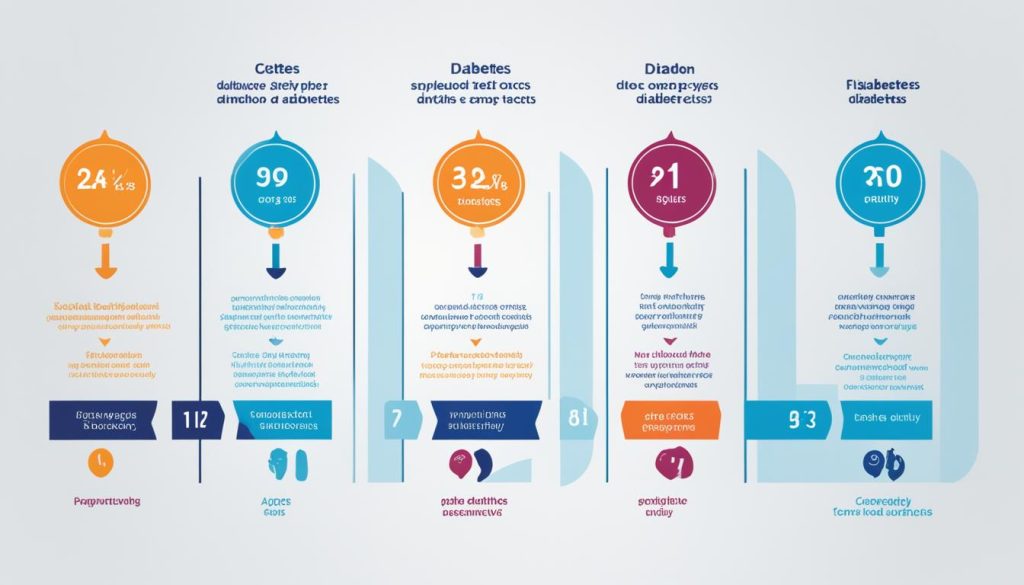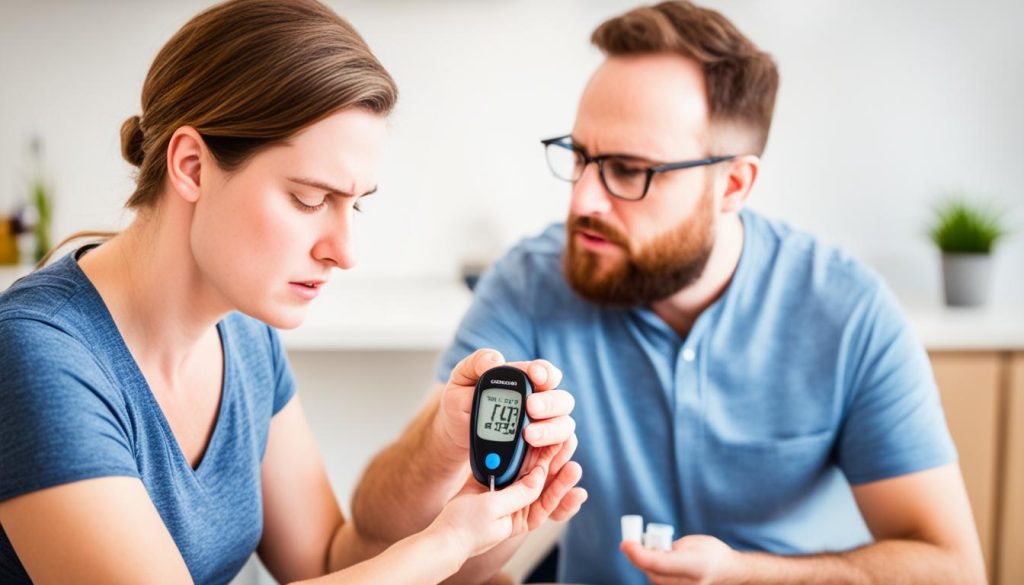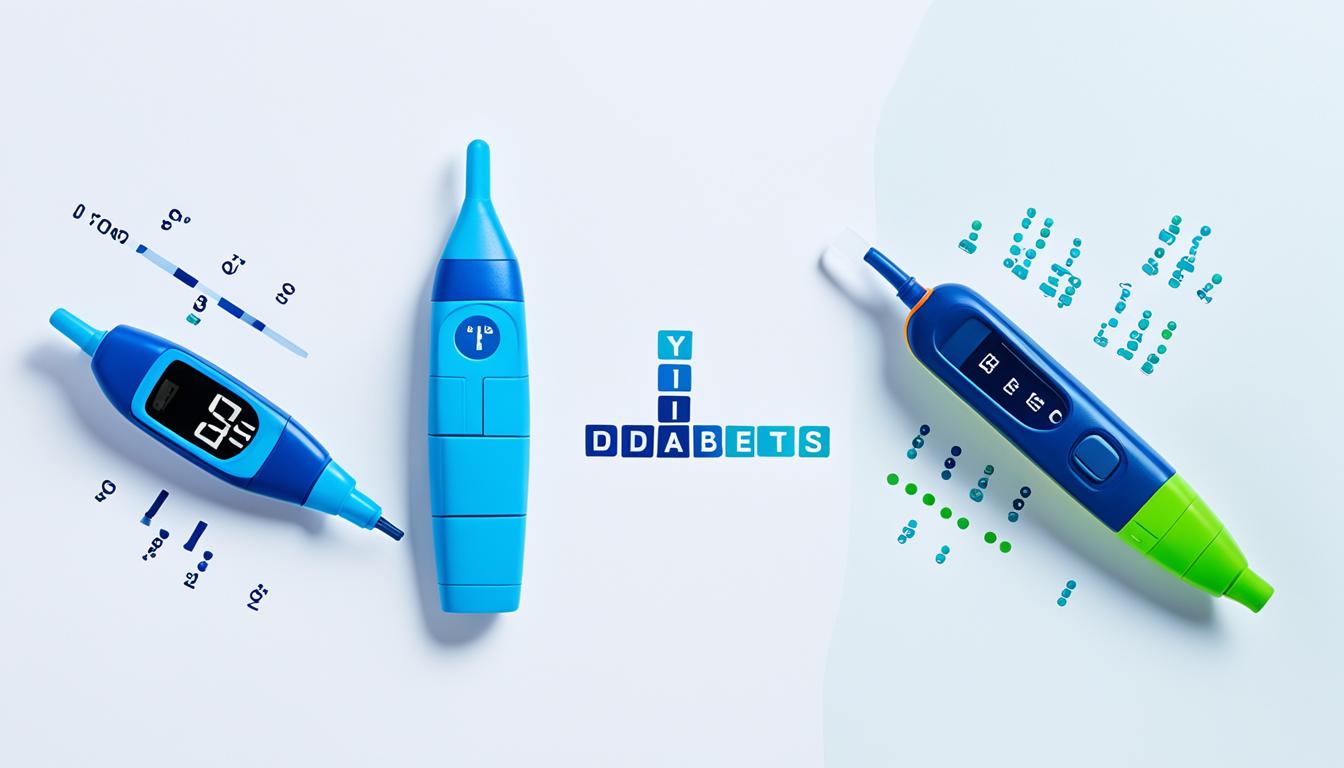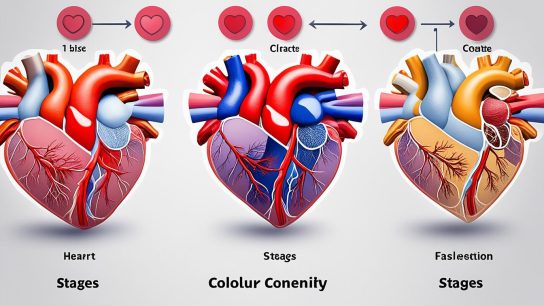Understanding the difference between type 1 and type 2 diabetes is essential in managing and treating these serious conditions. While both types are characterized by issues with insulin, the hormone that regulates blood sugar levels, they have distinct differences in their causes, symptoms, and management approaches.
Type 1 diabetes is an autoimmune condition where the body’s immune system attacks and destroys the insulin-producing cells in the pancreas. On the other hand, type 2 diabetes is characterized by insulin resistance, where the body either doesn’t produce enough insulin or doesn’t effectively use the insulin it produces.
Although only 8% of people with diabetes have type 1, it is more commonly diagnosed in childhood, while type 2 diabetes affects 90% of people with diabetes and is often diagnosed in adults over the age of 45. Managing both types of diabetes requires proper treatment, lifestyle changes, and support.
In this article, we will explore the causes, risk factors, symptoms, management strategies, as well as the emotional impact and support available for individuals living with type 1 and type 2 diabetes. By the end, you will have a clear understanding of the distinctions between the two types and how to best navigate and manage the complexities of diabetes.
What is the Difference Between Type 1 and Type 2 Diabetes?
Causes and Risk Factors
The causes of type 1 diabetes are not yet fully understood, but it is believed to be a combination of genetic and environmental factors. Type 1 diabetes is considered an autoimmune condition where the immune system mistakenly attacks the insulin-producing cells in the pancreas.
On the other hand, type 2 diabetes can be caused by a combination of genetic factors, family history, lifestyle choices, age, ethnicity, and obesity. Insulin resistance, where the body does not effectively use the insulin it produces or doesn’t produce enough insulin, is a key factor in type 2 diabetes.
Genetic factors play a significant role in both types of diabetes. Having a family history of diabetes increases the risk of developing the condition. Age is another risk factor, with type 1 diabetes commonly diagnosed in childhood and type 2 diabetes often diagnosed in adults over the age of 45.
Furthermore, ethnicity can influence the risk of type 2 diabetes, as certain ethnic groups such as African-Caribbean, Black African, Chinese, or South Asian populations are more susceptible to the condition.
Obesity is also a significant risk factor for type 2 diabetes. Excess body weight and an unhealthy lifestyle, including a poor diet and lack of physical activity, increase the likelihood of developing type 2 diabetes.
Understanding the causes and risk factors associated with type 1 and type 2 diabetes is crucial for early detection, prevention, and effective management.
Symptoms
Both type 1 and type 2 diabetes exhibit similar symptoms, including frequent urination, excessive thirst, fatigue, unexplained weight loss, blurred vision, and slow wound healing. These symptoms serve as early signs of diabetes and should not be ignored.
Type 1 diabetes may present its symptoms more rapidly, often accompanied by abrupt weight loss. In some cases, if left untreated, it can lead to a serious condition called diabetic ketoacidosis (DKA). On the other hand, symptoms of type 2 diabetes tend to develop more gradually and can easily go unnoticed, resulting in delayed diagnosis and treatment.
It is crucial to recognize the signs and symptoms of diabetes and seek medical attention promptly. Early detection and management can prevent complications and improve overall health outcomes.

- Frequent urination
- Excessive thirst
- Fatigue
- Unexplained weight loss
- Blurred vision
- Slow wound healing
If you experience any combination of these symptoms, it is advisable to consult with a healthcare professional for proper diagnosis and guidance on managing diabetes effectively.
Management
Managing diabetes is crucial for ensuring optimal health and quality of life. Whether it’s type 1 or type 2 diabetes, effective management strategies can help individuals maintain blood sugar control and minimize complications.
1. Insulin Therapy
For individuals with type 1 diabetes, insulin therapy is a cornerstone of management. Insulin can be administered through multiple daily injections or via an insulin pump, which delivers a continuous supply of insulin into the body.
2. Carbohydrate Counting
Carbohydrate counting is a valuable tool used by individuals with type 1 diabetes to balance insulin doses with the amount of carbohydrates consumed. This practice helps in maintaining stable blood sugar levels and prevents spikes or drops.
3. Healthy Lifestyle
A healthy lifestyle plays a crucial role in managing both type 1 and type 2 diabetes. Regular physical activity, such as walking, swimming, or cycling, can help improve insulin sensitivity and regulate blood sugar levels. Additionally, adopting a balanced diet that includes a variety of foods, emphasizing whole grains, lean proteins, fruits, and vegetables, is essential for overall well-being.
4. Regular Health Checks
Regular health checks are vital for diabetes management. This includes monitoring blood sugar levels, cholesterol levels, blood pressure, and conducting regular foot exams. These health checks allow early detection of any potential complications and enable timely intervention.
5. Medication
In addition to lifestyle modifications, medication may be necessary for individuals with type 2 diabetes to achieve optimal blood sugar control. Medications such as oral antidiabetic drugs or injectable medications like GLP-1 receptor agonists or insulin may be prescribed based on individual needs. It’s important to follow the prescribed medication regimen and consult with a healthcare professional.
6. Blood Sugar Control
Monitoring and maintaining blood sugar control is paramount in diabetes management. Regularly monitoring blood sugar levels using a glucose meter or continuous glucose monitoring system helps identify patterns and make informed adjustments to treatment plans.

Cure and Prevention
While there is no permanent cure for type 1 diabetes, ongoing research is dedicated to finding ways to delay or prevent the onset of the disease. Scientists and medical professionals are continuously exploring innovative approaches to address the root causes and develop effective preventive measures for type 1 diabetes.
On the other hand, type 2 diabetes can be prevented or put into remission with the right strategies. Weight loss plays a crucial role in managing type 2 diabetes, as it can significantly improve insulin sensitivity and glucose control. Following a very low-calorie diet under medical supervision has shown promising results in achieving diabetes remission in some cases.
Certain surgical procedures, such as bariatric surgery, have also demonstrated the potential to induce remission in type 2 diabetes by promoting weight loss and metabolic changes. However, these procedures are typically reserved for individuals with severe obesity and can have associated risks and considerations.
Prevention strategies for type 2 diabetes revolve around adopting a healthy lifestyle and making conscious choices. Maintaining a healthy weight through regular physical activity and a balanced diet is key in reducing the risk of developing type 2 diabetes. By managing modifiable risk factors such as family history and ethnicity, individuals can take proactive steps towards preventing the onset of type 2 diabetes.
Research on Type 1 Diabetes Cure
Ongoing research on type 1 diabetes aims to find ways to regulate and restore insulin production in the body. Scientists are exploring various approaches, including stem cell therapies, immunomodulatory treatments, and beta cell transplantation. By understanding the underlying mechanisms and developing targeted interventions, researchers strive to achieve long-term remission or even a cure for type 1 diabetes.
Nevertheless, it is important to note that diabetes research is a complex and evolving field. While advancements are being made, it may take time before a definitive cure for type 1 diabetes is available. In the meantime, individuals with type 1 diabetes can effectively manage their condition through insulin therapy, regular monitoring, and a healthy lifestyle.
| Type 1 Diabetes | Type 2 Diabetes | |
|---|---|---|
| Curability | No permanent cure | No permanent cure, but can be prevented or put into remission |
| Research Focus | Delayed onset and prevention | Prevention and remission strategies |
| Main Factors | Autoimmune condition | Insulin resistance, lifestyle choices |
| Prevention Strategies | – | Healthy lifestyle, weight management |
| Treatment | Insulin therapy | Lifestyle modifications, medication if necessary |
Risk Factors and Age Range
While both type 1 and type 2 diabetes have some genetic components, there are additional risk factors associated with each type.
Type 1 diabetes
- Family History: Individuals with a family history of type 1 diabetes are at a higher risk of developing the condition.
- Age Range: Type 1 diabetes can occur at any age, but it is more prevalent in people under 40.
Type 2 diabetes
- Age: Type 2 diabetes is more strongly associated with age, particularly in individuals over 45.
- Family History: Having a family member with type 2 diabetes increases the risk of developing the condition.
- Ethnicity: Certain ethnic groups such as African-Caribbean, Black African, Chinese, or South Asian populations have a higher risk of developing type 2 diabetes.
- Obesity: Obesity is a significant risk factor for type 2 diabetes.
To illustrate the prevalence of risk factors, let’s take a look at the age distribution and obesity rates in individuals with type 1 and type 2 diabetes:
| Type 1 Diabetes | Type 2 Diabetes | |
|---|---|---|
| Age Range | Can occur at any age, more prevalent in people under 40 | More common in individuals over 45 |
| Obesity Rates | Lower prevalence compared to type 2 diabetes | Obesity is a significant risk factor for type 2 diabetes |

Understanding the risk factors and age range associated with type 1 and type 2 diabetes is crucial for early detection, prevention, and effective management. By recognizing these factors, individuals can take proactive steps to reduce their risk and maintain better overall health.
Emotional Impact and Support
Living with diabetes, whether it’s type 1 or type 2, can have a profound emotional impact on individuals. The constant need for self-care, the challenges of managing blood sugar levels, and the potential stigma associated with the condition can all contribute to emotional distress. It is important for individuals with diabetes to seek support and connect with others who understand their experiences.
One valuable resource for emotional support is helplines dedicated to diabetes. These helplines provide a listening ear, offering guidance, reassurance, and advice for managing the emotional aspects of living with diabetes. They can help individuals navigate the complexities of the condition and offer coping strategies to deal with the challenges that arise.
Online forums are also excellent platforms for connecting with others in the diabetes community. These forums provide a safe space to share experiences, exchange tips and advice, and find comfort in knowing that one is not alone in their journey. Participating in forums can foster a sense of camaraderie and provide individuals with valuable insights into managing their diabetes effectively.
Local support groups are another fantastic resource for individuals with diabetes. These groups bring together people in the same geographical area who are dealing with similar challenges. Attending local support group meetings allows individuals to forge connections, share stories, and gain support from those who truly understand. Not only do these groups provide emotional support, but they also offer educational resources and practical advice for diabetes management.

| Benefits of Emotional Support for Diabetes Management |
|---|
| 1. Provides a sense of belonging and community |
| 2. Reduces feelings of isolation and loneliness |
| 3. Offers a platform to share experiences and gain valuable insights |
| 4. Provides emotional reassurance and coping strategies |
| 5. Increases motivation and commitment to diabetes management |
Overall, seeking emotional support is an essential component of diabetes management. It can help individuals navigate the emotional challenges of the condition, reduce feelings of isolation, and provide practical insights into effective self-care. Whether through helplines, online forums, or local support groups, finding a community that understands and supports is invaluable on the diabetes journey.
Conclusion
Diabetes is a complex condition that affects millions of people worldwide. By understanding the key differences between type 1 and type 2 diabetes, individuals and healthcare professionals can work together to improve diagnosis, treatment, and overall management of the disease.
Type 1 diabetes, characterized by an autoimmune response, requires lifelong insulin therapy. On the other hand, type 2 diabetes can often be managed through lifestyle changes, medication, and regular check-ups.
Key takeaways for individuals with diabetes include close collaboration with healthcare professionals, adopting a healthy lifestyle that includes regular exercise and a balanced diet, and staying informed about the latest research and treatment options.
By taking an active role in diabetes management, individuals can better control their blood sugar levels, reduce the risk of complications, and lead healthier lives.




